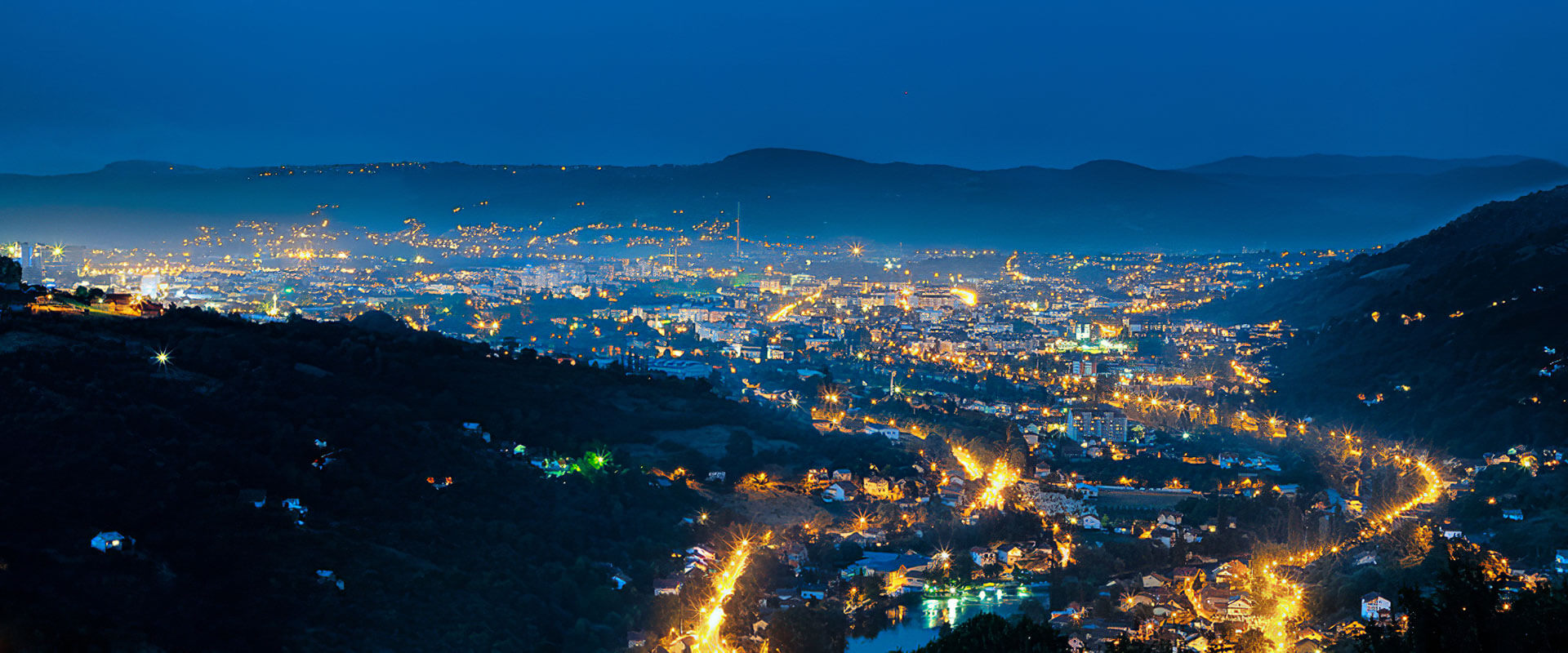BANJA LUKA (BANJALUKA)
Banja Luka (also written: Banjaluka) is the university, economic, finance, political and administrative center of the Republic of Srpska, which is one of the two entities in Bosnia and Herzegovina, situated in a valley of the Vrbas river at an elevation of 164 m above sea level. Banja Luka has a temperate continental climate and belongs to the Central European Time zone (GMT +1).
Climate
Temperate-continental
(average annual temperature – 10,7 °C)
Time zone
CET (GMT+1)
Phone code
+387
Zip code
051
Currency
Convertible mark (KM)
Postal code
78 000
The name of Banja Luka was first mentioned in 1494, but prehistoric archaeological sites and the items found prove that there were human settlements in this area in the period of Mousterian back to 50.000 – 35.000 B.C.
The city is located on the banks of the green mountain river Vrbas, which, along with the Kastel Fortress, has been always the symbol of the city. It is also known as the “city of greenery” because it is covered with a large number of green areas (parks and alleys). Although it changed its appearance over the centuries, each of the historical milestones created a certain historical and cultural heritage that remains recognizable to this day. Banjaluka is adorned with a number of tourist attractions, cultural, sports and musical events, offering a choice for every visitor.
More about our city could be found at the following links:
https://en.banjaluka.rs.ba/tourism/
https://www.banjaluka-tourism.com/index.php/en/
KASTEL FORTRESS
Kastel fortress, the oldest and the most attractive monument of the city’s past, is located in the central part of the city along the banks of the Vrbas River. This green oasis is a favorite gathering and socializing place for the people of Banja Luka, and during the summer months it provides an unforgettable environment for holding numerous cultural events and international music festivals. In its interior, in addition to the summer stage, children’s playground and restaurant, there is also a stone house that functions as a gallery.
The fortress is located on an area of 48,000 square meters, surrounded by stone walls, on which loopholes and observation posts were built, which indicates that in the past it was a very strong military fortification, and historical data shows that it was impregnable.
On the basis of hodological tests, certain archeological findings, and ancient geographical maps, it was ascertained that the ancient (Roman) settlement of Castra was located on the territory of the Kastel fortress, in which there was a station (mansio), a military camp (castrum), a civilian settlement next to the camp (canabae) and a beneficiary station (statio). It belonged to the territory of the province of Upper Pannonia, and the area was inhabited by the Osseriates Illyrian tribe. The settlement of Castra was located on the road that started from Salona (Solin), then the political center of the Roman province of Dalmatia, to Servicii (Gradiška), at that time a port on the Sava river in the province of Pannonia. At the beginning of 1528, under the Ottoman Empire, Banjaluka became the seat of the Bosnian sannjak-bey, and the seat of the Bosnia Eyalet. The first beylerbey, Gazi Ferhad-paša Sokolović, had 216 buildings built, among which the armory (tophana ) was built. Tophana was turned into a fortress during the reign of Sultan Mehmed III (1595-1603). During the renovation under the reign of Numan Pasha Ćuprilić in 1712-1714. year, the fortress gets its final dimensions.
More about this interesting fortress could be found at the following link:
https://www.banjaluka-tourism.com/index.php/en/what-to-see/2016-12-05-14-56-49/fortress-kastel
Temple of Christ the Savior
The Church of Christ the Savior is the largest and the most beautiful Orthodox religious building in the city of Banja Luka. It is located in the city center between the buildings of the City administration and Banski dvor. It was built in 1939, damaged during the bombing during World War II, and soon after that completely destroyed. The restoration of the church was completed in 2010, and the remains of the old church were placed in front of the temple.
The temple is decorated with domes made of a special material that can last up to a thousand years, while the bell tower with a clock and a gilded cross 2.5 meters high particularly draw the attention .
Ferhat Pasha Mosque
Ferhat Pasha Mosque (Bosnian: Ferhat-pašina džamija, Turkish: Ferhad Paşa Camii), also known as the Ferhadija Mosque, is a mosque in the city of Banja Luka and one of the greatest achievements of Bosnia and Herzegovina’s 16th century Ottoman Islamic architecture.
According to legend, when Ferhadija was completed in 1579, Ferhat-Pasha, who had commissioned the work, had the builders locked inside the minaret, sentencing them to death so that they could never again make anything so beautiful. But one night they made wings and flew away and some parts of Banjaluka were named after them.


